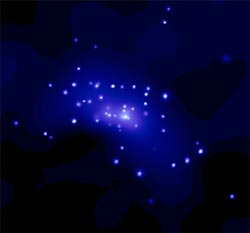Black holes in distant galaxies point to wild youth, Chandra discovers

Chandra’s image of the elliptical galaxy NGC 4697 <br>NASA/CXC/UVa/C.Sarazin et al.) <br>
Like ’flower power’ tattoos on aging ex-hippy baby boomers, unexpectedly large numbers of neutron stars and black holes in elliptical galaxies suggest some of these galaxies lived through a much wilder youth. The discovery by NASA’s Chandra X-ray Observatory may require a revision of how elliptical galaxies evolved.
“For the first time, Chandra has allowed us to distinguish hundreds of star-like sources that are black holes and neutron stars in distant elliptical galaxies,” said Craig Sarazin of the University of Virginia who presented his team’s findings on three elliptical galaxies, known as NGC 4697, NGC 4649, and NGC 1553, today at the American Astronomical Society meeting in Albuquerque, N.M. “The black holes and neutron stars we now see in these elliptical galaxies are reminders of their very active past.”
Black holes and neutron stars are the “stellar corpses” of the brightest, most massive and short-lived stars. The presence of numerous neutron stars and black holes shows that these galaxies once contained many very bright, massive stars. This is in marked contrast to the present populations of lower-mass, faint, old stars that now dominate elliptical galaxies.
The black holes and neutron stars found by Chandra in these galaxies appear to be members of binary star systems. The strong pull of gravity from the collapsed star pulls material off the normal star. This material emits large amounts of X-rays as it falls into the black hole or neutron star.
The Chandra observations also show that most of the binary star systems that contain black holes are not scattered randomly among the stars in the elliptical galaxies. Instead, most of the X-ray binaries are located in “globular star clusters,” round balls of stars, containing about one million stars in a region of the galaxy where typically only one would be found.
The high fraction of black hole binaries found in globular star clusters suggests that the black holes captured a single star or pulled it away from its original companion. Normally, the distances between stars in galaxies are too great for capture to occur, but in the extraordinarily dense environment of globular clusters they may be much more common.
“Chandra has shown us that the birthplace of these exotic black hole binary systems are in the dense globular clusters,” said Joel Bregman, a collaborator at the University of Michigan, Ann Arbor.
“Globular clusters appear to be the ’singles bars’ of the stellar world,” said Sarazin, “where a lonely black hole can go to find a companion.”
Other members of the research team include Elizabeth L. Blanton, Scott W. Randall, and Gregory R. Sivakoff, all of University of Virginia, and Jimmy Irwin of University of Michigan.
The observations were made with Chandra’s Advanced CCD Imaging Spectrometer, which was built for NASA by Penn State and the Massachusetts Institute of Technology, Cambridge, Mass. NASA’s Marshall Space Flight Center, Huntsville, Ala., manages the Chandra program for the Office of Space Science, Washington, D.C. TRW, Inc., Redondo Beach, Calif., is the prime contractor for the spacecraft. The Smithsonian’s Chandra X-ray Center controls science and flight operations from Cambridge.
Media Contact
All latest news from the category: Physics and Astronomy
This area deals with the fundamental laws and building blocks of nature and how they interact, the properties and the behavior of matter, and research into space and time and their structures.
innovations-report provides in-depth reports and articles on subjects such as astrophysics, laser technologies, nuclear, quantum, particle and solid-state physics, nanotechnologies, planetary research and findings (Mars, Venus) and developments related to the Hubble Telescope.
Newest articles

Properties of new materials for microchips
… can now be measured well. Reseachers of Delft University of Technology demonstrated measuring performance properties of ultrathin silicon membranes. Making ever smaller and more powerful chips requires new ultrathin…

Floating solar’s potential
… to support sustainable development by addressing climate, water, and energy goals holistically. A new study published this week in Nature Energy raises the potential for floating solar photovoltaics (FPV)…

Skyrmions move at record speeds
… a step towards the computing of the future. An international research team led by scientists from the CNRS1 has discovered that the magnetic nanobubbles2 known as skyrmions can be…





















